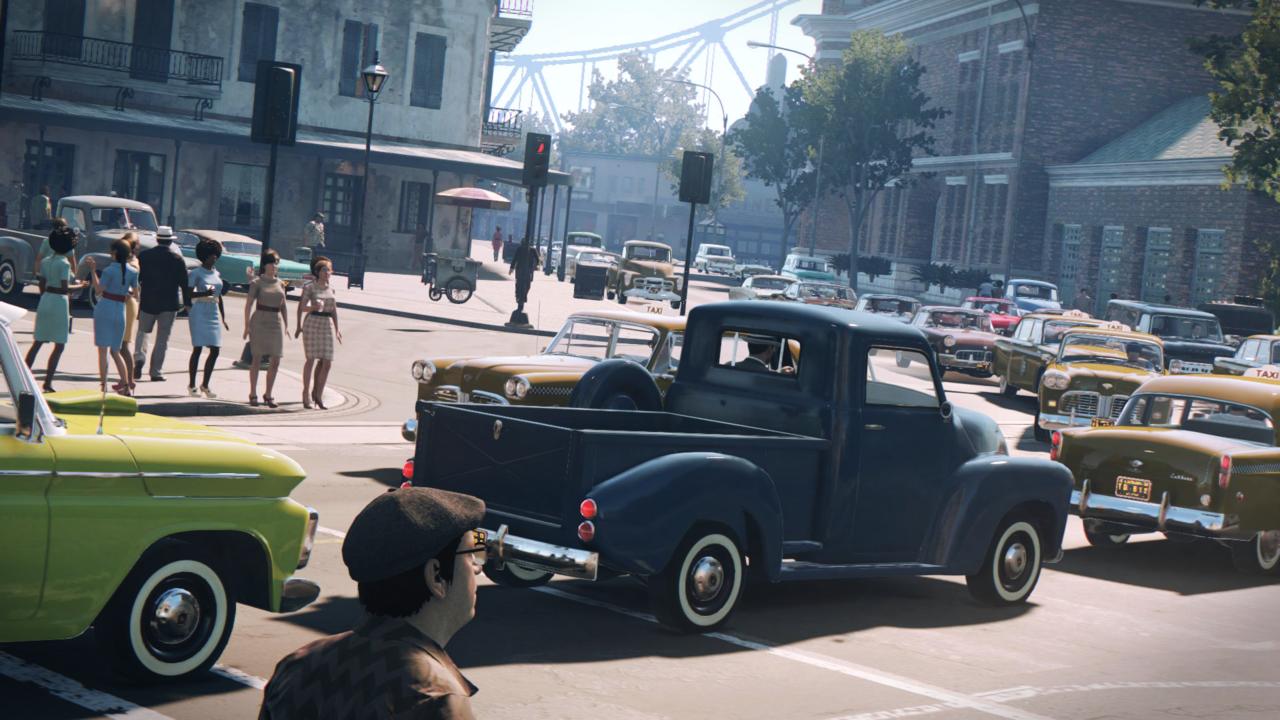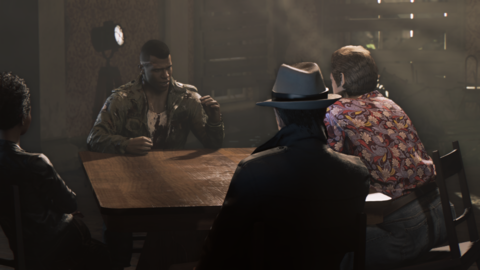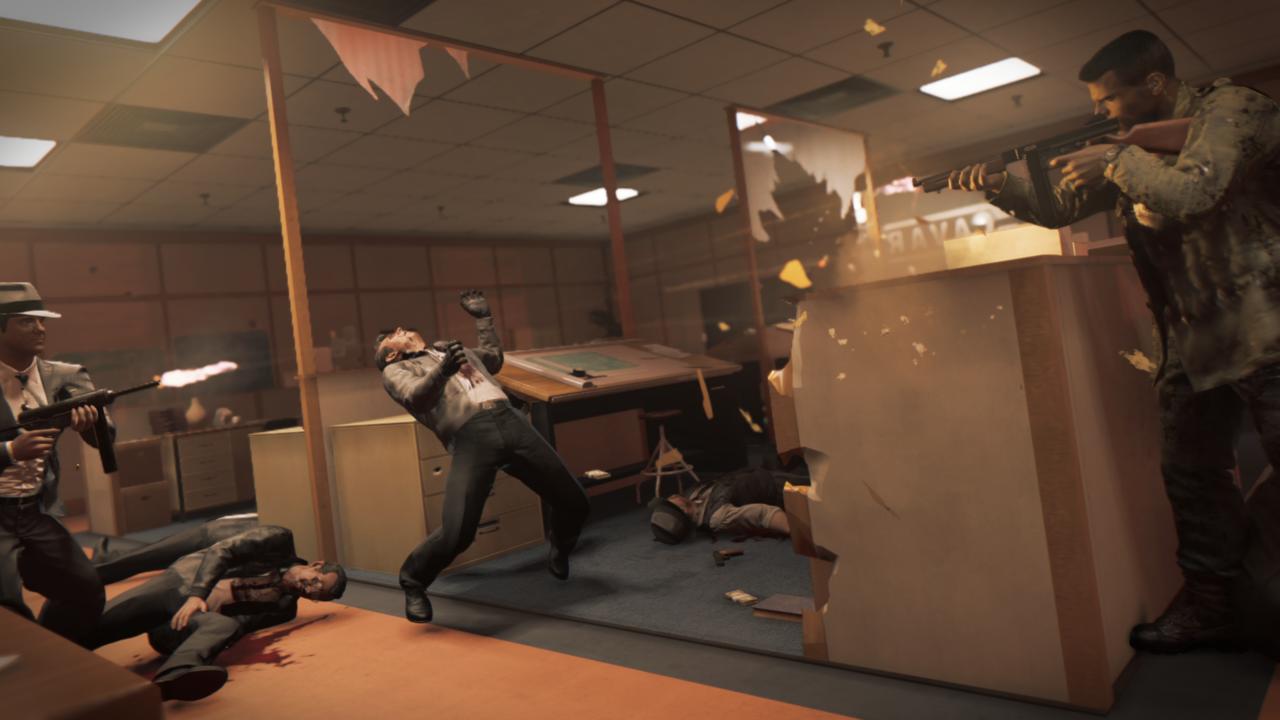Mafia III might be the most ambitious title in the series yet. Set in 1968 in a fictional version of New Orleans, Mafia III tells the story of Lincoln Clay, a Vietnam veteran who returns from the war to find his home in shambles. The black mob--the only thing he could ever call family--has been torn down, and the Italian mob has set up shop. With the help of the Irish mob, a self-exiled mobster from a big New England city, and the well-connected leader of the Haitian gangs, Lincoln will tear down the organization from within--and perhaps find a place to belong as well.
In development with Bay Area studio Hangar 13--named for its location in the hangars of the former Hamilton Field Air Force Base--and 2K Czech, the developers of the first two Mafia titles, Mafia III is already laying new ground. It's the first open-world game in the series, as well as the first to feature a biracial hero set during a time in the Deep South when racial tensions were at their most divisive. Through this conflicted anti-hero--he's a hard criminal raised by the mob, there's no mincing words--players will claim the city of New Bordeaux for their own, breaking crime rackets down and building them up to their own liking.
"I wanted to build games that really tried to push the notion that the players co-author in the experience," creative director Haden Blackman told GameSpot on the founding of Hangar 13, which was built to bring up Mafia. "We have that tag line for Hanger 13, that every player's story is unique. That's definitely something we want to try and push for everything that we do." And during a recent hands-on session, we learned that there are indeed many opportunities for crafting your own story, for making Mafia III your own Mafia.

This is the first truly open world Mafia game, but it still has those cinematic moments characteristic of previous games.
"We didn't want to go so far in that direction that we broke the stuff that worked very well with Mafia II," Blackman said. "There is a very strong narrative that is pulling you through, and everything that you do feeds back into that narrative. I think our media team is doing a fantastic job. The cinematics are coming together really well."
2K is hoping to "reclaim the term 'Mafia'" with Mafia III, by setting it during a time period when the mafia began to lose its glory.
"As a writer, I didn’t want to go back to the world and tell the same kind of rags to riches story, or a guy working his way up from the bottom," explained lead writer Bill Harms. "We are going to try and find a different twist on that and a different spin to it, which is where I think having [Lincoln] being a different type of mobster came in. The other thing that really came to play: this goes back to the time period. We did a ton of research for this game. Before we ever wrote a word, hours and hours of research went into this. One of the things that we all came away with is that in the 60s, it was kind of the end of the golden age of the Italian mob. Before that, people didn’t really even acknowledge that the Italian mob existed. If they did, it was, ‘Well they're just a social club, they're good for the neighborhood.’"
The game is framed as a documentary detailing the events of 1968 involving lead character Lincoln.
Between large missions, we'll see Jon Donovan--a new character--speaking in a courtroom about the events surrounding Lincoln's activities. These scenes look like they've been pulled off an old VHS tape. These are pieces of a documentary made about Lincoln's activities, and provide the narrative framework for Mafia III. This was inspired by all the research the Mafia team did for the story, and a nod to the numerous documentaries the team had to watch.
Metaphor: ReFantazio The King’s Trial Trailer Tales of the Shire - Official Announcement Trailer Dead Island 2 – Steam Launch Trailer Nickelodeon All-Star Brawl 2 - Official Zuko Gameplay Spotlight Trailer Valheim: Ashlands - Official Gameplay Trailer Tales of Kenzera: ZAU GameSpot Video Review 2XKO - Official Illaoi Champion Gameplay Reveal Trailer Destiny 2: The Final Shape | Journey into The Traveler Trailer Solo Leveling: Arise - Character Gameplay Teaser #15: Seo Jiwoo Genshin Impact - Character Demo - "Arlecchino: Lullaby" Goddess Of Victory: Nikke | Last Kingdom Full Animated Cinematic Trailer GODDESS OF VICTORY: NIKKE | Kilo Character Motion Demonstration Trailer
Please enter your date of birth to view this video
By clicking 'enter', you agree to GameSpot's
Terms of Use and Privacy Policy
The city of New Bordeaux has nine districts, each with its own distinct look, atmosphere, and missions.
Mafia III's take on New Orleans includes nine separate districts. One, the French Ward, was revealed last year at Gamescom following the game's announcement. Our recent hands-on demo took us to New Bordeaux's downtown area, which is situated between the high-end district and the poor district. There's also an industrial ward, a suburban area, a harbor, a shipyard, and the Bayou, the swamps to the south of the city where mobsters tend to hide their most prized secrets.
"There's crime run out of the Bayou, but it doesn't have the same structure as some of the other districts, where they're running kind of a criminal enterprise out of it," Blackman said. "You go to the Bayou to do a lot of damage to some of the other rackets that rely on the area. [For example,] there's a moonshining racket in one of the districts, and you can go to the Bayou to hunt down and destroy some of the stills--because that's where they've hidden the stills."
Each district will have its own unique crime rackets.
Every place has its own problems. In Mafia III, you'll encounter an extortion racket in a bathhouse, illegal seizing and re-selling of gasoline and construction materials, drug and prostitution rings, and even a moonshine business. Once Lincoln takes over these districts, he will start getting a cut of what they earn, bulking up your wallet.
Protagonist Lincoln Clay is biracial, an orphan, and a Vietnam veteran--which stacks a lot of decks against his desire to find a place he belongs.
According to Blackman and Harms, Lincoln's driving force is a search for a place to call home--hence his falling in with the black mob on his return from Vietnam. Having spent his childhood in an orphanage only to be moved to a foster home during America's routine shuttering of orphanages country-wide, Lincoln never really had one. After leaving the orphanage, Lincoln is taken under the wing of Sammy Robinson, the head of the black mob, and becomes friends with Sammy's son Ellis. But they're still not his blood family, and he never feels he truly belongs.

You will build relationships with your subordinates that affect your personal and professional life--of crime, that is.
Lincoln will have three people working under him: the mysterious Haitian gang leader Cassandra, the boisterous Irishman Burke, and Vito--the protagonist of Mafia II now residing in New Bordeaux. After Lincoln busts up operations in a mobster safehouse or conquers a district, he will have the opportunity to hand off its management to one of these three. After each territory is conquered, Lincoln and his comrades will have what Hangar 13 is calling a "sitdown," where they sit around a table and give Lincoln reasons why they should have the territory.
Entrusting a safehouse or entire district to one person has its pros and cons. Giving Burke territory will provide you with more backup in combat. Burke provides Lincoln with underlings that, when called in combat, will show up with weapons and help you take down opponents. This is particularly helpful in sticky situations when you know you're outgunned and need a few extra bodies on your side. It also helps that their aim is spot on. As you give Burke more to work with, he in turn will give you more support.
This is the same for Vito, who in exchange for territory will you give you access to better weapons and items. Giving Vito power means more and better guns, more protective gear, and other equippable items. Cassandra's offerings are the only outlier, as she gives you more control over combat spaces instead of physical items. Cassandra has friends in high places at the phone companies, and Lincoln can call her in combat and have her cut the phone lines in a specific area to prevent reinforcements from coming.
Favoring one associate or another will cause the other two to get feisty, deriding Lincoln for his decisions. You also can't unlock every perk these three give you in one playthrough--you have to think about what you want more when deciding who to curry favor with. For example, giving all your territory to Burke will anger Vito and Cassandra, which means you won't get that super powerful gun Vito has.
"This is by no means an RPG," Blackman said of this relationship system. "But I'm a huge RPG fan, and the thing I love most about the ones that do [relationships] well is that relationships evolve over time. We knew we wanted some element of that, but we wanted to do it in a different way than anybody had done it before."
Wire-tapping makes everything easier.
You have the option to wire-tap each sub-area of a district. Wiretapping will not only grant you access to your enemies' phone lines, it also links to one of Lincoln's abilities. A click on the analogue stick brings up your Intel Vision, which shows you how many enemies are in the area, where they are, and which one is your target or the squealer that will call reinforcements. This is incredibly useful--but only available if you've wiretapped the place beforehand. Wiretapping is done by locating the phone box--usually somewhere in enemy territory with a bit of a puzzle to get through--and activating it. This will feed enemy conversations directly into your ear, granting you more information to plan your next moves.

When you interrogate people, you can either kill them or make them work for you.
Obviously the latter has the most benefits, bringing you money and resources. But you can also choose to completely clean up shop and kill that safehouse owner or racket leader before handling it all off to Vito, Cassandra, or Burke.
Missions are open-ended and can be tackled a number of different ways.
There are several ways to handle things, whether it be sneaking in, grabbing want you want and getting out, or going in guns blazing. Each mission has its own checklist of tasks in order to get to the boss at the end, but in some cases, one action or another will allow you to bypass a few of those points, letting you go right to top if you're ready. Or, you could still choose to take out all subordinates, if you’re a completionist that likes to leave no mess behind and maybe have fewer obstacles blocking your final target.
I was given a few options for bringing down one particular racket. Rather than sneak into a hideout, I chose to go in guns raised, call in a squad of Irish mobsters to help me, and pick everyone off one by one. It took me a few tries--and eventually I decided to enter the building from a different entrance, but by coming in on a middle floor instead of the basement, I was able to wipe everyone out successfully.
Later, I had two choices for infiltrating the hotel where my target lived. I could go the garage, steal a car, and engage in some subterfuge, or I could walk into the hotel lobby and start shooting. I went with the latter and had to battle my way up multiple floors of a penthouse, tossing molotovs to wipe out multiple mobsters at once.

Depending on what paths you take, you'll see different content. The place and time matter.
You can stop some actions from happening--like someone get murdered--or let them happen. Who lives and dies is sometimes up to you, depending on where you are and when. For example, one mission required I steal money from a construction site. I snuck into through the back without killing anyone and the money I needed was just lying on the desk. Beyond the money, through a doorway, I saw two mobsters preparing to murder two men. I found out later that I could have just grabbed the money and ran, leaving those two to die. But instead I ran forward and killed the mobsters--but just a second too late to save the men. Later, in a cutscene, I heard someone ask what happened to one of those guys, not knowing he was dead.
Muscle cars handle like muscle cars in real life.
During my hands-on time with Mafia III's vehicles, I had a difficult time steering the classic cars of the 1960s, which handle like giant boats. According to Blackman, this design decision was intentional. The team wanted these cars to be just unwieldy enough to feel true-to-life in their handling. I eventually get a solid grip on driving them around, but it did take some time.
You will unlock different cars throughout your playthrough, and when you're out on foot, you can even call someone to deliver them to your location. You can also upgrade your fleet with things like improved suspension and handling, as well as stronger tires that can't be shot out. And yes, you can steal vehicles from NPCs--but you can't keep them.

The soundtrack is unique and contains a ton of licensed music.
You'll be able to take out rackets to the stylings of Creedence Clearwater Revival, Aretha Franklin, Lonnie Youngblood, and Sam Cooke--all artists of the period. As I was driving through the streets of New Bordeaux, The Rolling Stones' "Paint It Black" and The Animals' "House of the Rising Sun" came on. Blackman was particularly passionate about making sure Mafia III had a soundtrack to match the setting.
"1968 was such an interesting time on so many levels, and it all comes out in the music, the kind of crush of cultures and philosophies and ideals all comes out in the music," Blackman explained. "You’ve got that pop thing going on, the crooner still going on, you’ve got RnB really exploding, then you’ve got the hard rock stuff and the British invasion. It’s all colliding at this time and everybody is stealing from each other in terms of musical ideas and the music starts to really evolve rapidly. For us, it was important we have that wide swipe of music."
Additionally, you won't be blasted by hard-hitting strings and drums as you shoot your way through missions. Instead, you'll be treated to sassy, brassy jazz and other period music. I worked my way through an elaborate puzzle-like setup in a hotel, and as I moved between floors, I was accompanied by the swanky drawl of trumpets and trombones. It was hardly boss fight music, but it was unique and fun. The rest of the score includes themes from each character, tunes that evolve throughout the game, Blackman said, changing as they change.

